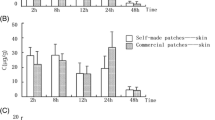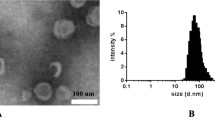Summary
Ointments containing griseofulvin and proquazone, respectively, were made up of monoglycerides of medium chain length and an aprotic solvent, glycerinformal. The ointments were applied topically on the back of bile cannulated rats. The total amount absorbed percutaneously and the permeability constants of both drugs were considerably higher for the ointments than for simple solutions of the drugs without monoglycerides. Distribution of the labeled drugs in rat skin has been demonstrated by microautoradiography. Concentrations of the drugs in the different layers of human skin together with the medium flow rates have been determined 16h after administration of the ointments onto isolated human skin. Monoglycerides of medium chain length enhance significantly the permeability of the stratum corneum for solutes.
Zusammenfassung
Salben mit Griseofulvin respektive Proquazon wurden aus Monoglyceriden mittlerer Kettenlänge und einem aprotischen Lösungsmittel, Glycerinformal, hergestellt und auf dem Rücken von Gallefistelratten appliziert. Die percutan resorbierten Mengen sowie die Permeabilitätskonstanten sind für beide Wirkstoffe wesentlich höher nach Applikation der Salben als nach Applikation von einfachen Wirkstofflösungen ohne Monoglyceride. Die Verteilung der markierten Wirkstoffe in Rattenhaut wurde durch Mikroautoradiographie kontrolliert. Die Konzentrationen der Wirkstoffe in den einzelnen Schichten von menschlicher Haut sowie die mittleren Penetrationsraten wurden 16 h nach Applikation der Salben auf isolierte menschliche Haut bestimmt. Monoglyceride mittlerer Kettenlänge erhöhen die Permeabilität des Stratum corneum für gelöste Wirkstoffe wesentlich.
Similar content being viewed by others
References
Blank H, Scheuplein R (1964) The epidermal barrier. In: Rook A, Champion RH (eds) Percutaneous absorption and the epidermal barrier. Progress in the biological sciences in relation to dermatology 1. Cambridge University Press, Cambridge, pp 245–261
Eckert H (1970) Autoradiographischer Nachweis löslicher Substanzen im licht-und elektronen-mikroskopischen Bereich. In: Hoffmann G, Ladner H-A (eds) Radioisotope in Pharmakokinetik und klinischer Biochemie. Schattauer, Stuttgart New York, pp 129–132
Epstein W, Shah V, Jones H, Riegelmann S (1975) Topically applied griseofulvin in the prevention and treatment of trichophyton mentagrophytes. Arch Derm 111:1293–1297
Munro D, Stoughton R (1965) Dimethylacetamide (DMAC) and Dimethylformamide (DMFA). Effect on percutaneous absorption. Arch Derm 92:585–586
Schaefer H, Stüttgen G (1978a) Penetration eines nicht steroidalen Antiphlogistikums in die menschliche Haut in vitro und in vivo. Arzneim Forsch 28:1021–1023
Schaefer H, Stüttgen G, Schaller W, Gazith J, Bauer E (1979) Principles of percutaneous absorption. In: Cohen Y (ed) Proceedings Int Congr Pharmacol 7th. Adv Pharmacol Ther 9. Pergamon, Oxford, pp 223–235
Schaefer H, Stüttgen G, Zesch A, Schalla W, Gazith J (1978b) Quantitative determination of percutaneous absorption of radiolabeled drugs in vitro and in vivo by human skin. In: Simon GA, Paster Z, Klingberg MA, Kaye M (eds) Skin: drug application and evaluation of environmental hazards. Current Problems in Dermatology 7. Karger, Basel München Paris London New York Sydney, pp 80–94
Scheuplein R (1978) Permeability of the skin: a review of major concepts. In: Simon GA, Paster Z, Klingberg MA, Kaye M (eds) Skin: drug application and evaluation of environmental hazards. Current problems in dermatology 7. Karger, Basel München Paris London New York Sydney, pp 172–186
Shah V (1980) Griseofulvin absorption per os and percutaneous. In: Preusser H-J (ed) Proceedings of mycological symposia of the XII Int Congr of Microbiology Medical Mycology. Fischer, Stuttgart New York, pp 233–239
Weiss H, Dietschy J (1969) Failure of bile acids to control hepatic cholesterogenesis. Evidence for endogenous cholesterol feedback. J Clin Invest 48:2398–2408
Wester R, Maibach H (1977) Percutaneous absorption in man and animals: A perspective. In: Drill VA, Lazar MD (eds) Cutaneous toxicity. Academic Press, London New York San Francisco, pp 111–126
Wurster D (1978) Some physical-chemical factors influencing percutaneous absorption from dermatologicals. In: Simon GA, Paster Z, Klingberg MA, Kaye M (eds) Skin: drug application and evaluation of environmental hazards. Current problems in dermatology 7 Karger, Basel München Paris London New York Sydney, pp 156–171
Zarowny D, Rogers R, Tindall J (1975) Evaluation of the effectiveness of griseofulvin, tolnaftate, and placebo in the topical therapy of superficial dermatophytoses. J Invest Dermatol 64:268–272
Author information
Authors and Affiliations
Rights and permissions
About this article
Cite this article
Franz, J.M., Gaillard, A., Maibach, H.I. et al. Percutaneous absorption of griseofulvin and proquazone in the rat and in isolated human skin. Arch Dermatol Res 271, 275–282 (1981). https://doi.org/10.1007/BF00409456
Received:
Issue Date:
DOI: https://doi.org/10.1007/BF00409456




